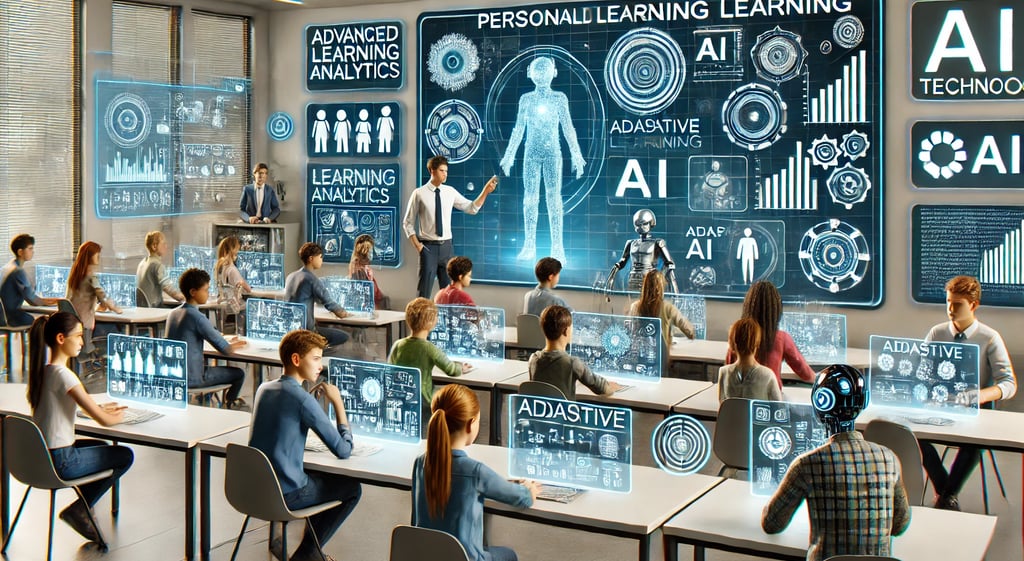The Role of AI in Modern Education: Personalized Learning Explored
This article explores the transformative role of AI in personalized learning, highlighting tools like adaptive platforms, real-time feedback, and learning analytics. Discover how AI enhances engagement, accessibility, and outcomes in education while addressing challenges such as data privacy and equity.
EDUCATION


The advent of Artificial Intelligence (AI) has revolutionized various industries, and education is no exception. Among its transformative contributions, personalized learning stands out as a game-changer. By leveraging AI-driven tools and methodologies, educators can cater to the unique needs, preferences, and learning paces of students. This article delves into the pivotal role AI plays in shaping personalized education, unlocking potential for learners and educators alike.
What is Personalized Learning?
Personalized learning is an educational approach tailored to meet the distinct requirements of each student. Unlike traditional, one-size-fits-all methods, it emphasizes customization of content, pacing, and teaching strategies. With AI, personalized learning becomes more efficient and impactful, offering insights and adjustments in real-time.
How AI Drives Personalized Learning
1. Adaptive Learning Platforms
AI-powered adaptive learning platforms like DreamBox and Khan Academy analyze students' performance to adjust lesson plans dynamically. These systems identify strengths, weaknesses, and preferences, offering tailored exercises to address gaps and build confidence.
2. Real-Time Feedback
Traditional assessments often involve delays in feedback. AI bridges this gap by providing instantaneous evaluations. Whether through AI tutors or intelligent grading systems, students receive constructive insights to improve continuously.
3. Enhanced Accessibility
AI tools like text-to-speech, speech-to-text, and language translation break down barriers for learners with disabilities or language differences. This inclusivity ensures every student has access to quality education, regardless of their background or needs.
4. Learning Analytics
AI processes vast amounts of data to uncover patterns in student behavior and performance. Teachers can use these insights to refine their approaches, ensuring no student is left behind.
Key Benefits of AI in Personalized Learning
Increased Engagement: Customized content keeps learners motivated and invested in their progress.
Improved Outcomes: Tailored instruction ensures better retention and comprehension of concepts.
Time Efficiency: Automation of repetitive tasks frees educators to focus on student interaction and mentorship.
Scalability: AI makes it feasible to deliver personalized learning at scale, even in large classrooms or online environments.
Challenges and Considerations
While the potential is immense, implementing AI in education isn't without hurdles:
Data Privacy: Collecting and analyzing student data necessitates stringent privacy measures.
Teacher Training: Educators need adequate training to integrate AI tools effectively.
Equity: Ensuring equal access to AI-driven resources across diverse socioeconomic groups remains a priority.
The Future of AI in Education
As AI technology evolves, its role in education will expand, paving the way for even more innovative solutions. Virtual reality classrooms, emotion-detecting AI systems, and AI-powered career guidance tools are just a few examples of what lies ahead. The ultimate goal remains the same: to empower students and educators with the tools they need for success in an ever-changing world.
Conclusion
AI has redefined personalized learning, turning it from a lofty ideal into an achievable reality. By catering to individual needs, AI fosters a more inclusive, efficient, and engaging educational experience. As we continue to explore its potential, AI promises to be an indispensable ally in modern education, shaping the minds of tomorrow.
FAQs
1. How does AI adapt to different learning styles?
AI tools analyze students' preferences and performance, recommending tailored content suited to visual, auditory, or kinesthetic learners.
2. Are AI-driven learning tools expensive?
While some tools may have initial costs, many are free or offer affordable options for schools and individuals.
3. Can AI replace teachers?
No, AI complements teachers by automating tasks and providing insights. The human touch remains irreplaceable in fostering emotional and social development.
For more insights on AI in education, visit "How to Introduce Kids to AI: Fun and Easy Learning Tools" (education focus) and "10 AI Courses That Can Land You a High-Paying Job" (advanced education in AI).